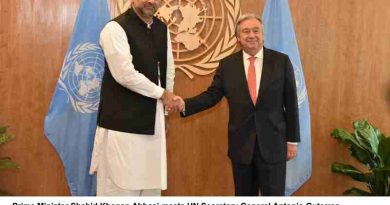Perpetual Human Rights Crisis in Myanmar: UN Report

Perpetual Human Rights Crisis in Myanmar: UN Report
Myanmar’s military has created a perpetual human rights crisis through the continuous use of violence, including the killing, arbitrary arrest, torture and enforced disappearance of anti-coup opponents, a report published by the UN Human Rights Office said today (March 3).
“Two years after the military launched a coup, the generals have embarked on a scorched earth policy in an attempt to stamp out opposition,” the UN High Commissioner for Human Rights, Volker Türk, said.
“Tragically, regional and global efforts for peace and restraint have largely fallen on deaf ears. The military, emboldened by continuous and absolute impunity, has consistently shown disregard for international obligations and principles. Urgent, concrete action is needed to end this festering catastrophe,” he added.
The report echoed calls by the Security Council and ASEAN for, among other things, an immediate halt to the violence, the release of all those arbitrarily detained, accountability, and unhindered humanitarian access.
The report documents a litany of human rights abuses from 1 February 2022 to 31 January 2023, accompanied by a sharp rise in violence especially in the north-western and south-eastern parts of Myanmar.
It cites credible sources as having verified the deaths of at least 2,940, and 17,572 arrests by the military and its affiliates since the coup. Nearly 80 per cent of the country’s 330 townships have been impacted by armed clashes.
The military employs its so-called four-cuts approach – including through indiscriminate airstrikes and artillery shelling, razing villages to displace civilian populations, and denial of humanitarian access – to cut off non-State organized armed groups and other anti-military armed elements from access to food, finances, intelligence and recruits.
Among the numerous incidents of airstrikes, on 16 September – in Let Yet Kone village, Tabayin Township, Sagaing – four helicopters opened fire on a school killing at least six children and injuring nine others. After some 60 soldiers deployed from helicopters to the ground, they reportedly raided the village, executing a school technician and five villagers before arresting wounded children and teachers.
In another incident, on 20 October, an airstrike against a newly opened hospital in Man Yu Gyi village, Banmauk Township, Sagaing, killed one woman and injured five others. A source reported that the hospital had been inaugurated a day earlier and victims were all volunteers at the facility.
One of the most frequently used tactics by the military is the systematic and widespread burning of villages and dwellings. Consistent with their modus operandi documented over decades, including in Kachin in 2011 and Rakhine in 2017, UN reports indicated that nearly 39,000 houses nationwide have been burnt or destroyed in military operations since February 2022, representing a more than 1,000-fold increase compared to 2021.
Sagaing was the most affected region, accounting for over 25,500 homes. In an incident on 1 May 2022 in Ah Shey See, Kale Township, Sagaing, satellite images suggest the burning of almost the entire village with 621 structures destroyed. Satellite imagery coupled with interview reports suggest that between 16 and 28 September in Taze Township, Sagaing, the military destroyed 458 houses and damaged another 319 across eight villages during a series of raids and attacks.
The military’s mismanagement of the economy has provoked an economic crisis for much of the population, resulting in the doubling of poverty rates compared to March 2020.
Nearly half of the population now lives in poverty, and rural populations are reported to be at risk of starvation as the military imposes further restrictions on access to areas affected by violence and conflict.
Compounding the situation, main supply routes and waterways across the country have been blocked, preventing humanitarian actors from reaching 17.6 million people in need.
“The military has also adopted rules, including martial law, intended to target anti-coup opposition and severely restrict the civic space that had significantly contributed to Myanmar’s democratic transition,” Türk said.






